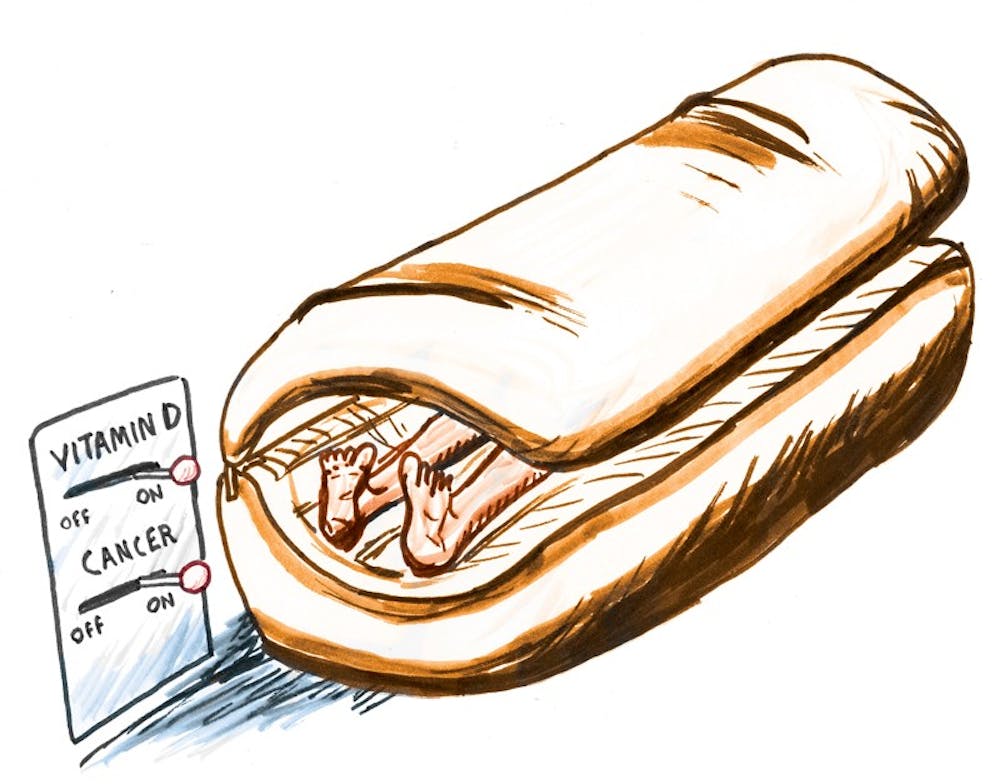Vitamin D does not rain from the sky, nor does it travel on the beams of sunlight to quench a thirsty body of its vitamin needs. It is, however, one of the few positive products of tanning.\nIn the 1920s, Coco Chanel overturned the fashionable preference for pale skin overnight when she appeared bronzed from a boating trip at several prestigious Parisian fashion shows. Before that time, the elite had remained indoors, fashionably lightening complexions with arsenic or lead powder, while farmers and laborers had worked outdoors acquiring a healthy tan. The social revolutions of the 1920s, however, lured the wealthy, upper classes to the great outdoors while the working classes spent many hours in dark factories, reversing the previous pattern and making tan skin the new desirable beauty must-have.\nToday, tanning remains a part of fashion culture, though the link with increased skin cancer has given tanning a poor reputation.\n"The risks primarily are due to increased chance of either skin cancer - squamous and basal cell - or malignant melanoma," Student Health Director Dr. James Turner said. "Melanoma is much more serious and can be deadly,"\nIn addition to cancer, large amounts of sun exposure can lead to collagen depletion in the skin, uneven skin tone leading to "premature aging and skin cancer," University Dermatologist Mark Russell said. Using a sunscreen of SPF 25 or more before prolonged sun exposure is key to avoid burning, Turner said.\nOther research, however, has come forward supporting unprotected sun exposure at least twice a week to combat the surprisingly widespread vitamin D deficiency from which many people all over the world suffer.\nDr. Michael Holick published an article in the New England Journal of Medicine surmising the condition of this all too common deficiency. According to his and others' research, vitamin D deficiency, in various forms, is linked to cancer, autoimmune diseases, osteoporosis, osteopenia, cardiovascular disease, schizophrenia, depression, wheezing and decreased lung function, muscle weakness, osteoarthritis and diabetes.\nAn estimated one billion people in the world have a vitamin D deficiency. In Boston, where the research was conducted, 32 percent of study participants had low levels of vitamin D even though they regularly took a multivitamin, drank milk and ate salmon, which contains a significant amount of vitamin D, about 400 IU or international units, a unit of measurement for vitamins.\nThe study concluded that a lack of sun exposure contributed heavily to the deficiency, and that sun exposure of the arms and legs for five to 30 minutes - depending on factors such as the time of day, skin pigmentation, latitude and season - twice a week is optimal for maintaining sufficient vitamin D levels. Adequate sun exposure can provide synthesis of around 3000 IU of vitamin D, on average.\n"To tell you the truth, I think a little bit of UV is good for vitamin D formation, but, of course, only in moderation," Russell said.\nThe crucial vitamin D component, vitamin D3, however, is synthesized in the skin with the aid of UVB rays. Areas above 35 degrees north latitude (Atlanta, Ga.) do not receive an adequate amount of these ultraviolet rays to enable D3 synthesis between November and February.\nEven during summer months in the northern hemisphere, it has been found that melanin in the skin can inhibit vitamin D3 synthesis up to 99 percent for dark skin. Additionaly, an SPF as low as 8 prohibits synthesis from UVB rays up to 92.5 percent, while SPF 15 and above limits synthesis by 99 percent. The article interestingly recommended tanning beds, which can emit two to six percent UVB radiation, as a source of vitamin D synthesis. Holick, however, cautioned that tanning beds be used only in moderation, noting that tanning beds and outside tanning are equally dangerous.\n"The United States Department of Health and Human Services has designated UV as a carcinogen," Russel said. "People say 'Oh, its natural,' but there are a lot of natural things that can harm you, like mercury, lead or asbestos. You can get vitamin D from some UV exposure, but it's when it's taken to the extreme that you get premature aging and cancer."\nKristin Daniels, a fourth-year College student and former assistant manager of a tanning salon, tans about three times a week in the spring and summer.\n"I prefer [tanning] salons because it's a controlled amount of UVA/UVB," she said.\nDespite possible health benefits, tanning beds nonetheless pose the risk of skin cancer.\n"[I am worried] to an extent," Daniels said. "The public magnifies the issues, but many also don't know the correct way to tan, so I'm not worried about me as much as I am for people who don't know what they're doing."\nThe desire for bronzed skin began as a status symbol and persisted as a fashion for various reasons. Turner suggested that tanning is inspired by "vanity, fashion [and] peer pressure." Or perhaps it provides a self-esteem boost.\n"Being tan makes you look five pounds thinner," Daniels said. "It makes me feel good about myself. Also, tanning releases serotonin and dopamine in the brain and stimulates oxygen in the blood combating my stress ... Tanning is a complex ritual."\nWhatever the psychological motivation, controlled amounts of tanning may now be acceptable for its potential to combat vitamin D deficiency, and along with it, a variety of other health concerns. As with most things, though, excessive indulgence can lead to several potentially dangerous conditions, such as skin damage and, even worse, an increased chance of developing skin cancer.
The Tanning, Cancer and Vitamin D-ebate
The risks and benefits of keeping a golden glow all year long







